When planning drone rescue payload delivery for survivors, you'll need to choose the right drone model with adequate payload capacity and flight time. Optimize weight distribution and implement efficient release mechanisms for your payload. Ascertain long-range communication capabilities and precise GPS navigation for accurate delivery. Weatherproof your drone system to withstand harsh conditions, and incorporate obstacle avoidance features for safe navigation. Plan for extended flight time and train operators for emergency scenarios. Don't forget to reflect on legal and ethical aspects of drone operations. With these tips in mind, you'll be better prepared to execute successful drone rescue missions and potentially save lives.
Choose the Right Drone Model
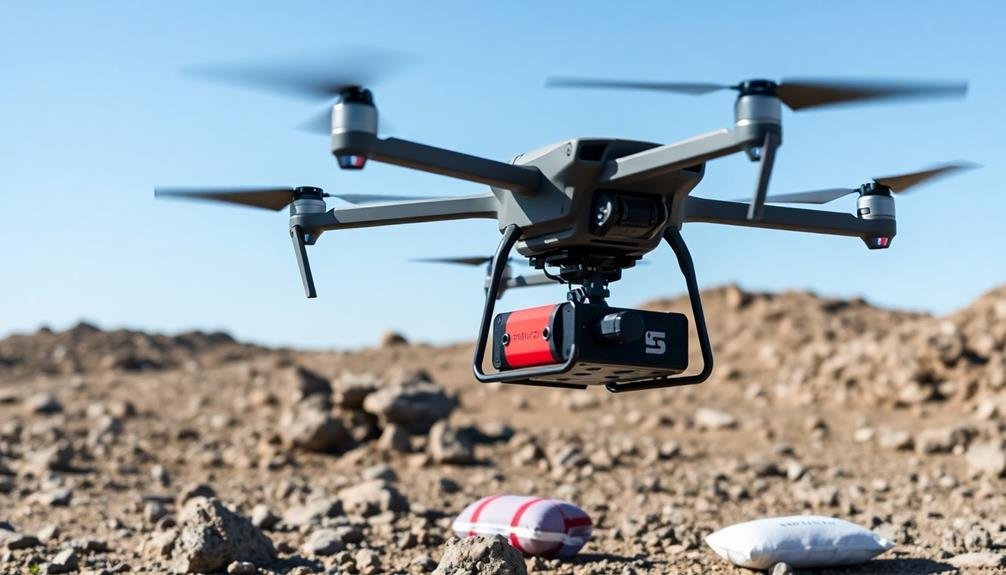
Selecting the appropriate drone is essential for successful rescue payload delivery.
You'll need to take into account factors like payload capacity, flight time, range, and durability when choosing your drone model. Opt for a drone with a high payload capacity to carry critical supplies like food, water, and medical kits. Look for models that can lift at least 5-10 pounds.
Flight time is imperative, so choose a drone with long-lasting batteries or the ability to swap batteries quickly. Aim for at least 30 minutes of flight time per battery.
Range is another significant factor; select a drone that can cover long distances, ideally 5-10 miles or more. This guarantees you can reach survivors in remote areas.
Durability is essential in challenging rescue environments. Pick a drone that's weather-resistant and can handle wind, rain, and extreme temperatures.
Take into account models with obstacle avoidance systems to prevent crashes in difficult terrain.
Optimize Payload Weight Distribution
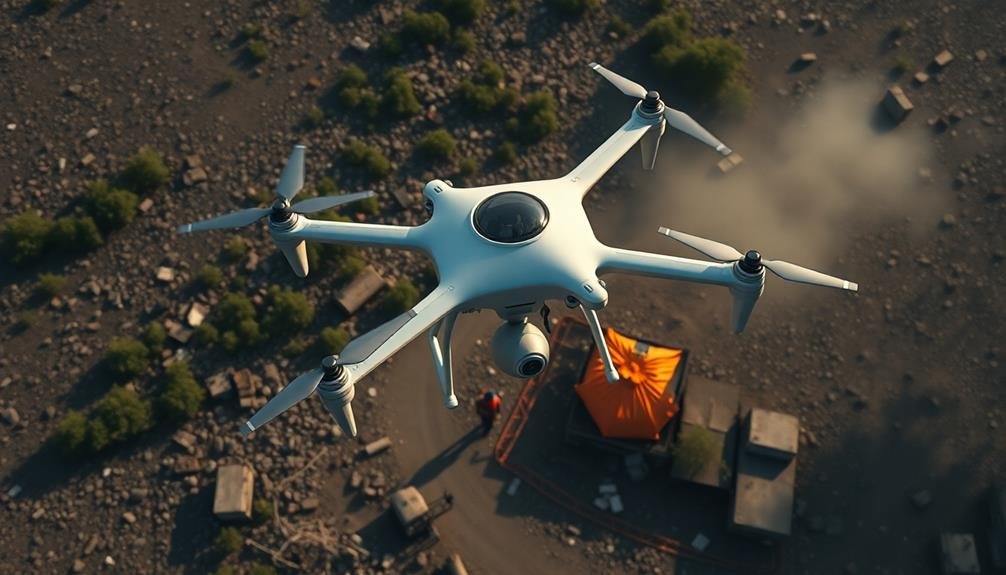
Balance is key when optimizing payload weight distribution for drone rescue missions. You'll need to carefully consider how you arrange items within the payload to maintain the drone's stability and performance. Start by placing heavier items as close to the center of gravity as possible. This will help prevent the drone from becoming unbalanced during flight.
Next, distribute the weight evenly across the drone's frame. If you're using multiple attachment points, guarantee that each one carries a similar load. This will prevent strain on any single point and improve overall flight characteristics. Consider using counterweights if necessary to achieve proper balance.
When packing supplies, think vertically as well as horizontally. Stack items strategically to minimize the payload's overall footprint and reduce drag. Use secure, lightweight containers to prevent shifting during flight. Remember that wind resistance increases with payload size, so aim for a compact, streamlined shape.
Don't forget to factor in the weight of the drone itself when calculating total payload capacity. Always stay within the manufacturer's recommended limits to guarantee safe and efficient operation.
Ensure Long-Range Communication Capabilities

For successful drone rescue missions, reliable long-range communication is essential. You'll need to make certain your drone can maintain a stable connection with the ground control station over extended distances. Invest in high-quality, long-range radio systems or satellite communication modules to maximize your drone's operational range.
Consider using mesh network technology to extend your communication capabilities. This allows multiple drones to relay signals, effectively increasing the overall range of your rescue operation. Don't forget to equip your drone with a backup communication system in case the primary one fails.
To create a vivid mental image of long-range communication in action, imagine:
- A drone soaring over a vast, storm-ravaged landscape, its antennas pulsing with data.
- A ground control team huddled around screens, receiving real-time footage from miles away.
- Multiple drones forming a network in the sky, relaying critical information to each other.
- A survivor's distress signal being picked up and transmitted back to the rescue team.
Remember to test your communication systems thoroughly before deployment. Conduct range tests in various conditions to guarantee reliability when it matters most.
Weatherproof Your Drone System

To guarantee your drone can operate in various weather conditions, focus on waterproofing its body design.
Equip your payload compartment with protective features to shield sensitive items from moisture and debris.
Don't forget to use rain-resistant electronic components to safeguard your drone's critical systems during inclement weather.
Waterproof Drone Body Design
Waterproofing your drone's body is essential for successful rescue payload deliveries in challenging weather conditions. To achieve this, focus on sealing all entry points for water, including joints, seams, and openings for components. Use high-quality silicone sealants or specialized waterproof coatings to create a protective barrier against moisture.
Consider upgrading your drone's frame to a water-resistant material like carbon fiber or reinforced plastic. These materials not only repel water but also offer improved durability and lightweight properties.
Don't forget to protect your drone's electronic components by encasing them in waterproof housings or applying conformal coatings.
To visualize an effective waterproof drone design, imagine:
- A sleek, seamless exterior with no visible gaps or openings
- Water beading up and rolling off the surface upon contact
- Sealed battery compartments with rubber gaskets
- Propellers with hydrophobic coatings spinning off water droplets
Remember to test your waterproofing efforts thoroughly before deploying your drone in real-world rescue scenarios. Submerge it in water under controlled conditions to identify any weak points in your design.
Protective Payload Compartment
A resilient payload compartment is essential for protecting valuable rescue supplies during drone missions. You'll want to guarantee your compartment is weatherproof, shock-resistant, and secure. Start by choosing a sturdy material like reinforced plastic or lightweight aluminum. Seal all edges with waterproof gaskets and use rubber grommets for any cable entry points.
Consider incorporating a cushioning system inside the compartment to absorb impacts and vibrations. Foam inserts or air cushions can help protect delicate items. Don't forget to include a reliable locking mechanism to prevent accidental openings during flight.
Here's a quick reference guide for payload compartment features:
| Feature | Purpose | Example |
|---|---|---|
| Material | Durability | Carbon fiber |
| Sealing | Weatherproofing | Silicone gaskets |
| Cushioning | Impact protection | Custom foam inserts |
To maximize payload capacity, design the compartment with a streamlined shape that minimizes drag. If you're operating in extreme temperatures, add insulation to maintain stable conditions for temperature-sensitive items. Finally, guarantee easy access for quick loading and unloading of supplies, as time is critical in rescue operations.
Rain-Resistant Electronic Components
While protecting your payload is essential, safeguarding your drone's electronic components from rain is equally important. Guarantee your drone can operate reliably in wet conditions by implementing rain-resistant measures.
Start by applying a hydrophobic coating to your drone's circuit boards and connections. This invisible layer repels water, preventing moisture from seeping into sensitive electronics.
Next, seal all openings and gaps in your drone's body with silicone or rubber gaskets. Pay special attention to areas around battery compartments, camera mounts, and control interfaces.
Install waterproof connectors for all external ports, including charging and data transfer points.
To create a vivid picture of a rain-resistant drone, consider these key features:
- Streamlined body with smooth, water-shedding contours
- Enclosed propellers with water-resistant motors
- Sealed camera housing with a hydrophobic lens coating
- Waterproof battery compartment with rubberized seals
Don't forget to regularly maintain your drone's rain-resistant features. Inspect seals, replace worn gaskets, and reapply hydrophobic coatings as needed.
Implement Precise GPS Navigation

To implement precise GPS navigation for your rescue drone, start by mastering waypoint-based flight planning.
You'll need to incorporate real-time position corrections to maintain accuracy during changing conditions.
Don't forget to equip your drone with obstacle avoidance systems, ensuring safe navigation even in complex environments.
Waypoint-Based Flight Planning
Frequently, precise GPS navigation through waypoint-based flight planning forms the backbone of successful drone rescue missions. You'll need to master this skill to efficiently deliver payloads to survivors in need. Start by plotting your route using digital mapping software, marking key locations as waypoints. These should include takeoff and landing zones, delivery points, and potential obstacles.
When creating your flight plan, consider these vital factors:
- Terrain elevation changes that might affect your drone's altitude
- No-fly zones or restricted airspace along your route
- Weather conditions, including wind speed and direction
- Battery life and range limitations of your drone
Program your waypoints into the drone's flight controller, ensuring each point is accurately placed. Set specific actions for each waypoint, such as hovering, descending, or releasing the payload.
Test your flight plan in a simulator before attempting the actual mission. This allows you to identify and correct any issues without risking your equipment or compromising the rescue operation.
Real-Time Position Corrections
During flight, even the most meticulously planned waypoint routes can encounter unexpected challenges. To guarantee accurate payload delivery, you'll need to implement real-time position corrections using precise GPS navigation. Equip your drone with a high-quality GPS receiver that supports RTK (Real-Time Kinematic) or PPK (Post-Processed Kinematic) technology for centimeter-level accuracy.
Integrate an inertial measurement unit (IMU) to complement GPS data and maintain positioning during brief signal losses. Use differential GPS (DGPS) techniques to further enhance accuracy by leveraging ground-based reference stations. Implement a Kalman filter algorithm to fuse data from multiple sensors, reducing errors and improving overall navigation performance.
Monitor satellite availability and geometry (GDOP) in real-time, adjusting flight paths if necessary to maintain peak positioning. Utilize GNSS assistance data to speed up satellite acquisition and improve accuracy in challenging environments.
Consider implementing a multi-constellation GNSS receiver to access GPS, GLONASS, Galileo, and BeiDou satellites for increased coverage and reliability. Regularly update your drone's firmware and navigation software to benefit from the latest improvements in positioning algorithms.
Obstacle Avoidance Systems
Obstacle avoidance systems are essential for ensuring safe and efficient payload delivery in rescue operations. These systems use sensors and advanced algorithms to detect and avoid potential hazards in real-time, allowing your drone to navigate complex environments with ease.
To implement an effective obstacle avoidance system for your rescue drone, consider the following key components:
- LiDAR sensors: These emit laser pulses to create detailed 3D maps of the surrounding area, enabling precise obstacle detection.
- Stereo cameras: Dual-lens cameras provide depth perception, helping your drone judge distances and identify potential hazards.
- Ultrasonic sensors: These emit sound waves to detect nearby objects, particularly useful in low-light conditions or when visual sensors are compromised.
- AI-powered collision prediction: Machine learning algorithms analyze sensor data to anticipate potential collisions and adjust flight paths accordingly.
Utilize Thermal Imaging Technology

Thermal imaging technology is a game-changer for drone rescue operations. It allows you to detect heat signatures of survivors, even in low-visibility conditions or dense vegetation. By equipping your drone with a thermal camera, you'll greatly increase your chances of locating people in need of assistance.
When using thermal imaging, remember these key points:
| Advantages | Limitations |
|---|---|
| Detects body heat | Can't see through walls |
| Works in darkness | Affected by ambient temperature |
| Penetrates smoke | Limited range |
To maximize the effectiveness of thermal imaging:
- Fly at ideal altitudes for best coverage and resolution.
- Scan methodically in a grid pattern to guarantee thorough coverage.
- Look for heat signatures that contrast with the surrounding environment.
Don't rely solely on thermal imaging; combine it with visual cameras and other sensors for a thorough search approach. Train your operators to interpret thermal images correctly, as different materials and environmental factors can affect readings. By integrating thermal imaging into your drone rescue payload, you'll enhance your ability to locate and assist survivors quickly and efficiently in various emergency scenarios.
Develop Efficient Payload Release Mechanisms
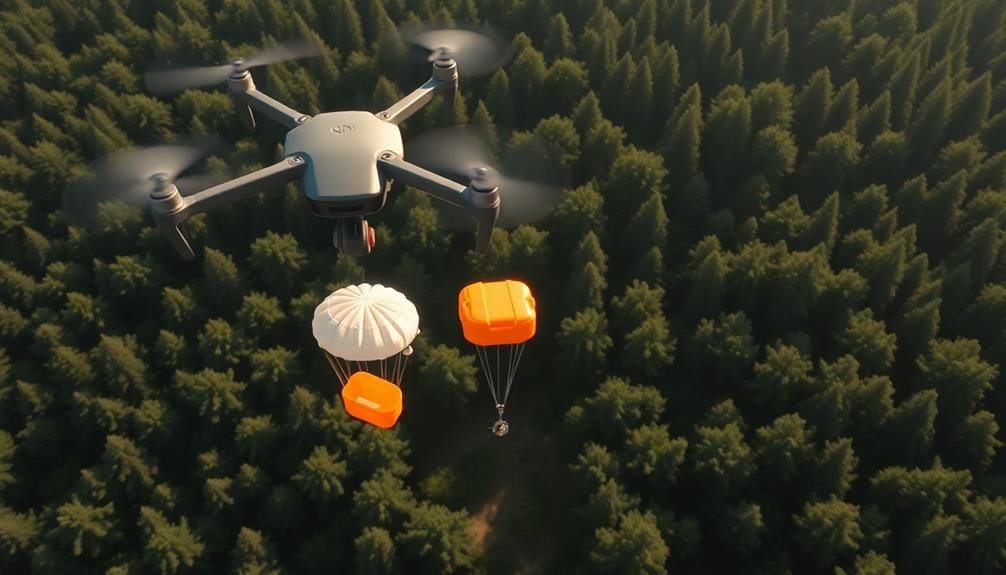
Once you've located survivors, delivering essential supplies efficiently becomes paramount. Developing effective payload release mechanisms guarantees rapid and accurate delivery of life-saving resources.
You'll want to focus on creating systems that are both reliable and easy to operate remotely. Consider implementing a servo-controlled drop mechanism that allows for precise timing and positioning. This system should be capable of releasing payloads of various sizes and weights, adapting to different rescue scenarios.
Confirm your release mechanism is weather-resistant and can function in challenging environmental conditions.
To create an efficient payload release system, focus on these key elements:
- A streamlined design that minimizes air resistance during flight
- Quick-release hooks or clamps for instant payload deployment
- Shock-absorbing materials to protect sensitive supplies upon landing
- Modular components for easy maintenance and replacement in the field
Test your release mechanisms thoroughly under various conditions to ensure consistent performance. Incorporate fail-safes to prevent accidental releases and guarantee payloads remain secure during transit.
Incorporate Obstacle Avoidance Features
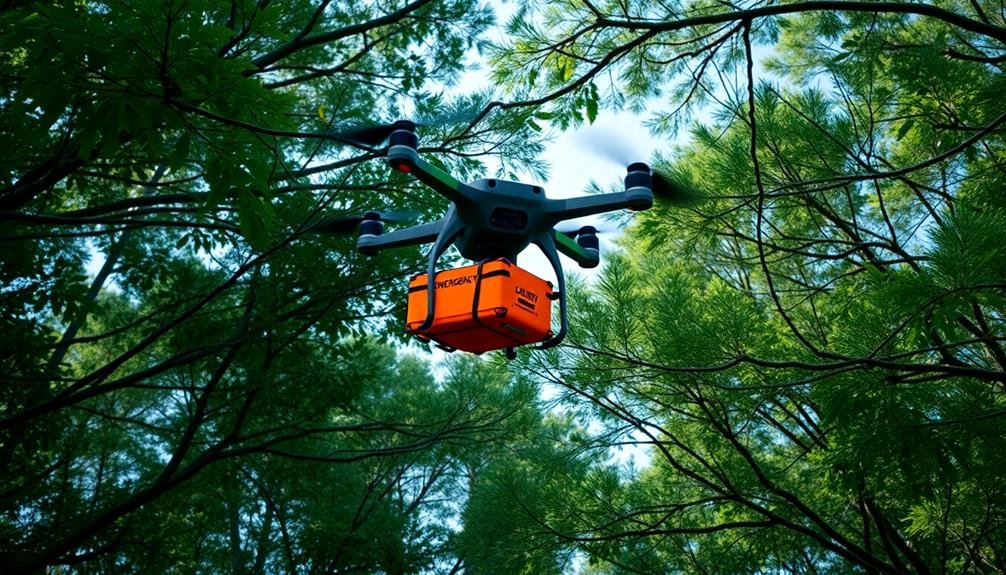
Maneuvering complex environments safely is a key challenge in drone rescue operations. To guarantee successful payload delivery, you'll need to incorporate advanced obstacle avoidance features into your drone system.
Start by equipping your drone with multiple sensors, including LiDAR, ultrasonic, and infrared sensors. These will provide a thorough view of the surroundings and detect obstacles in real-time.
Implement collision avoidance algorithms that can process sensor data quickly and make split-second decisions. You'll want to program your drone to maintain a safe distance from obstacles while maneuvering towards the target location.
Consider using simultaneous localization and mapping (SLAM) technology to create a 3D map of the environment as the drone flies.
Don't forget to integrate obstacle avoidance with your flight planning software. This will allow you to pre-plan routes that minimize potential hazards.
You should also implement failsafe protocols that prioritize obstacle avoidance over mission objectives if a collision risk is detected.
Plan for Extended Flight Time

Extending your drone's flight time is essential for successful rescue missions. You'll need to maximize every second in the air to reach survivors and deliver critical supplies. Start by selecting high-capacity batteries that offer the best power-to-weight ratio. Consider carrying spare batteries for quick swaps in the field. Optimize your drone's aerodynamics by removing unnecessary attachments and streamlining its profile.
To further improve flight time, follow these strategies:
- Use lightweight materials for payload containers, reducing overall weight without compromising durability.
- Program efficient flight paths that minimize energy consumption, avoiding unnecessary climbs and descents.
- Leverage weather conditions, such as tailwinds, to conserve battery power during long-distance flights.
- Implement power-saving features like reduced LED brightness and optimized motor performance.
Monitor battery levels closely and establish predetermined return points to guarantee safe landings. Train your team to perform rapid battery changes, minimizing downtime between flights.
Consider using solar panels or portable charging stations in the field to replenish batteries quickly. By focusing on extended flight time, you'll appreciably increase your drone's range and ability to reach survivors in remote or challenging locations.
Train Operators for Emergency Scenarios
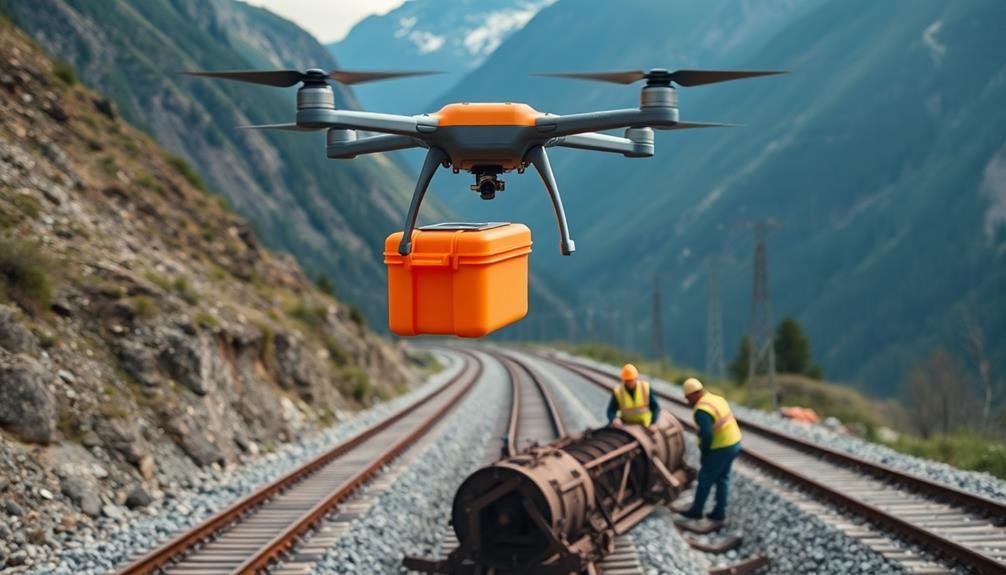
Proper training for drone operators is essential when it comes to emergency scenarios. You'll need to guarantee your team is well-versed in handling various situations that may arise during rescue missions.
Start by creating a thorough training program that covers both technical and practical aspects of drone operation in emergencies.
Focus on teaching operators how to navigate challenging weather conditions, maintain communication in areas with poor signal, and quickly assess the situation on the ground.
Include simulations of different rescue scenarios, such as delivering supplies to flood-affected areas or locating survivors in remote locations. Train your team to make split-second decisions and prioritize payloads based on urgency.
Emphasize the importance of maintaining a calm demeanor under pressure and following established protocols.
Teach operators how to troubleshoot common drone issues mid-flight and implement backup plans when necessary. Regular drills and refresher courses will help keep skills sharp and guarantee operators are prepared for any emergency.
Don't forget to include training on legal and ethical considerations, as well as coordination with other rescue teams on the ground.
Frequently Asked Questions
How Do Rescue Drones Compare to Traditional Search and Rescue Methods?
You'll find rescue drones are faster and more efficient than traditional methods. They can cover vast areas quickly, access hard-to-reach locations, and provide real-time aerial views. They're also safer for rescuers in dangerous situations.
What Are the Legal Restrictions for Using Drones in Rescue Operations?
You'll face legal restrictions when using drones for rescue. You must comply with aviation regulations, obtain proper licenses, respect privacy laws, and follow local guidelines. Don't fly in restricted airspace or interfere with other rescue operations.
Can Rescue Drones Be Used at Night or in Low-Visibility Conditions?
You can use rescue drones at night or in low-visibility conditions. They're often equipped with thermal cameras and bright lights. However, you'll need special authorization and trained operators to guarantee safety and effectiveness in these challenging environments.
How Do Survivors Signal Their Location to Rescue Drones?
You can signal rescue drones using bright colors, reflective materials, or flashlights. Wave your arms or create large SOS patterns on the ground. Some drones detect heat signatures or respond to mobile phone signals. Stay visible and patient.
What Types of Payloads Are Most Effective for Different Rescue Scenarios?
You'll find different payloads work best for various scenarios. For water rescues, use life rafts and buoys. In wilderness, pack food, water, and first aid kits. Urban disasters require tools, batteries, and communication devices. Always include emergency blankets.
In Summary
You've now got the essential tips for effective drone rescue payload delivery. Remember, your success hinges on thorough preparation and the right equipment. Don't underestimate the importance of training and practice. Stay up-to-date with regulations and emerging technologies. By following these guidelines, you'll be ready to make a real difference when every second counts. Keep honing your skills and stay safe out there – lives may depend on your expertise.

As educators and advocates for responsible drone use, we’re committed to sharing our knowledge and expertise with aspiring aerial photographers.




Leave a Reply